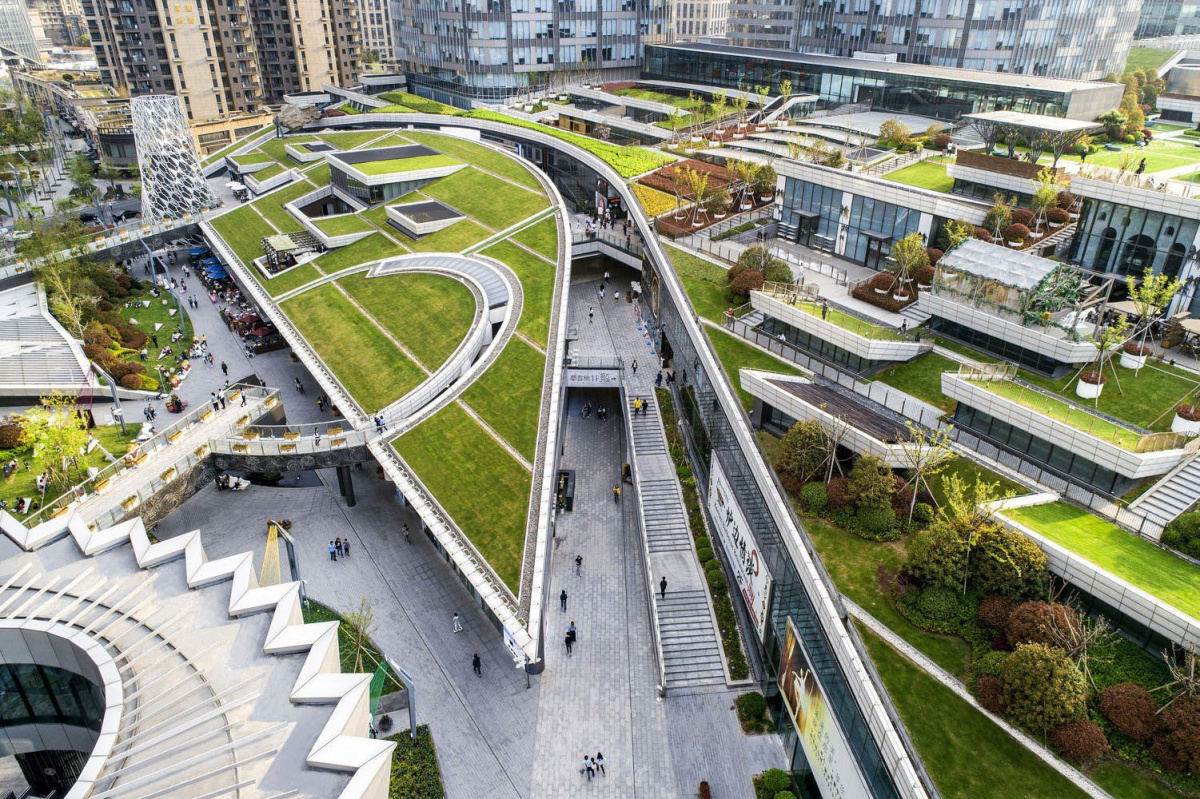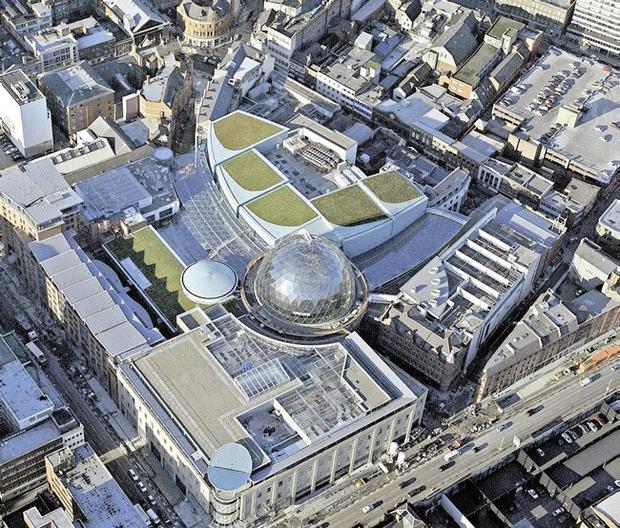Green Roofs and Vertical Gardens – nature-based solutions to climate change in an urban context

The climate crisis is forcing us to change our cities for the best response to impending social, economic and environmental disruptions and traditional systems like white painted roofs and walls, along with new solutions are taking over worldwide.
Medellín, Colombia is a city developing a series of imaginative responses to the climate crisis. These include planting ‘green corridors’ along roads and waterways, providing shady paths for pedestrians and cyclists. Already, this has cut temperatures on busy thoroughfares by 3 degrees Celsius. And it has had a healing impact on communities, too, with people who had suffered years of violence coming together to be trained as city gardeners.
Green - or living - roofs have been growing in popularity over the past decade as a small but significant way to reduce carbon emissions, whilst providing sound and heat insulation for certain types of building. The UK was ahead of the curve by beginning to implement innovative nature-based solutions over 10 years ago, with a boom of green roofs and vertical gardens in new developments including a few successful projects in Northern Ireland.
In 2013, Antrim Hospital became one of the first examples in Northern Ireland of a “living roof”, along with the "vertical garden" of the Skainos building in Belfast, which was part of a ground-breaking project on the Lower Newtownards Road commissioned by East Belfast Mission in 2012.
Here in Northern Ireland, the climate crisis will increase the intensity of rainfall and flooding, as well as extreme heat. The key to managing floodwater in an urban setting is to soak up water as it falls, absorbing the force of any flood and slowing its pace, by making our city landscapes less like a smooth sheet of concrete and more like a sponge.
In the London Borough of Hammersmith and Fulham, regeneration specialist Groundwork has worked with the council to ‘spongify’ the environment of three housing estates. Cue green roofs for apartment blocks, ‘renaturalised’ surfaces in place of concrete, and new growing beds. Some 20 residents have been employed as green team trainees, and delivering energy-saving (and money-saving) kits in the homes has helped win the support of the community (source: Positive News).
What are green roofs and vertical gardens?
A green roof (also known as a living roof or occasionally an eco-roof) is a roof or deck where vegetation or habitat for wildlife is deliberately established. The German Landscape Research, Development and Construction Society (FLL), and the Green Roof Code of Practice in the UK, divides green roofs into two major categories: intensive and extensive. These terms refer to the intensity of maintenance required.
Green walls (also known as vertical gardens) are divided by the UK National Building Certification (NBS) into three categories. Green façades: these are the traditional green walls where climbing plants are rooted into the ground or into planter boxes. Living walls: these are proprietary systems, installed and maintained as a package. Bioactive façades: building materials (often modified concrete) that have surfaces which are deliberately created to provide opportunities for self-supporting vegetation like algae and mosses - the aim being to create inexpensive, low maintenance green walls in locations where more heavily vegetated systems are not feasible.
Skainos Building Case Study
In Belfast the Skainos building is an example of positive social and envrionmental regeneration, where adopting nature-based solutions in architecture has provided screening, helped to reduce noise, and reduced heat loss from the building.
- 10,675m² development located on a two-acre site
- social and affordable housing, community facilities, commercial space, a day nursery and a café
- accommodation for 26 homeless people.
- 500m² "vertical garden"
- 6,500 hardy plants – evergreens, ground covers, grasses, ferns, and mosses
Demolition rubble was crushed and re-used on site and a displacement piling system was used to minimise waste removed off site. Along with Code for Sustainable Homes Level 3 rating, to achieve BREEAM “excellent” rating the building also has:
- natural ventilation and a biomass boiler
- solar thermal panels on the roof which generate hot water
- intelligent lighting controls which reduce energy consumption
The plants condition the air, remove pollutants, and provide seasonal colour and vegetation. The roof gardens are effective to harbour natural flora and fauna. This project’s scope had clear climate and biodiversity focused actions. On one hand, climate change by reducing outdoor temperature and lower indoor temperature through improved insulation, which decreases the use of air conditioning in summer and heating in winter and reduces the carbon footpring of the building. On the other hand, the creation of new habitats in an urban environment has increased green space in a deprived area and boosted biodiversity. Besides the improvement of energy efficiency, emissions reduction, and the general environmental quality (air quality and noise exposure) there have been wider economic impacts, such as more tourism, and attraction of businesses and investment in a deprived area (source: Urban Nature Atlas).
Future opportunities
 When compared to the rest of the UK, in particular London, the innovation demonstrated in this project, which was the first of its kind in Ireland and the biggest in UK at the time, now seems obsolete, since very few similar projects have followed beside green roofs on Antrim Hospital and Victoria Square shopping centre in Belfast. However Belfast City is planning to invest more in blue and green infrastructure in recognition of the fact that vegetated areas (the green) and our waterways (the blue) provide a broad range of economic, social, and environmental benefits in and around urban areas. As such, we need to think of these natural and semi-natural assets as ‘infrastructure’ and like any type of infrastructure, these assets will only continue to provide us with benefits if we actively plan, invest in, and manage them to ensure that they are utilised sustainably (source: Belfast Green and Blue Infrastructure Plan 2020).
When compared to the rest of the UK, in particular London, the innovation demonstrated in this project, which was the first of its kind in Ireland and the biggest in UK at the time, now seems obsolete, since very few similar projects have followed beside green roofs on Antrim Hospital and Victoria Square shopping centre in Belfast. However Belfast City is planning to invest more in blue and green infrastructure in recognition of the fact that vegetated areas (the green) and our waterways (the blue) provide a broad range of economic, social, and environmental benefits in and around urban areas. As such, we need to think of these natural and semi-natural assets as ‘infrastructure’ and like any type of infrastructure, these assets will only continue to provide us with benefits if we actively plan, invest in, and manage them to ensure that they are utilised sustainably (source: Belfast Green and Blue Infrastructure Plan 2020).
A report by European Federation of Green Roof and Walls Associations revealed in 2019 the remarkable growth of green roof space installed in London in the last 10 years. The report measured the success of the Living Roofs and Walls Policy that was included in the London Plan in 2008. It also showed how the policy has encouraged uptake of these measures in the absence of any financial incentives or mandatory requirements. The latest data collected showed that in 2017 there were 0.17 m2 of green roof per person in London and that in over 10 years 6 million jobs have been created (source: London Green Roof Map). An important element of the market is the number of direct and indirect jobs the green roof market provides to the economy each year. Whilst there are green roof suppliers and installers, green roofs also have an indirect employment sector, with associated professions in planning, design and maintenance of green roofs as well as their implementation (source: The UK Green Roof Market)
Local authorities in Northern Ireland have the potential to make their urban areas greener by investing more in nature-based solutions and green and blue infrastructures. Nature is our greatest ally in tackling climate change. These measures will greatly support local communities in their efforts to mitigate and adapt to climate change, whilst regenerating the local area and boosting the local economy.

